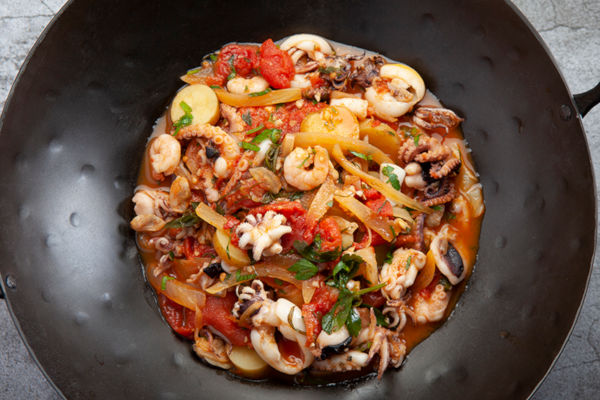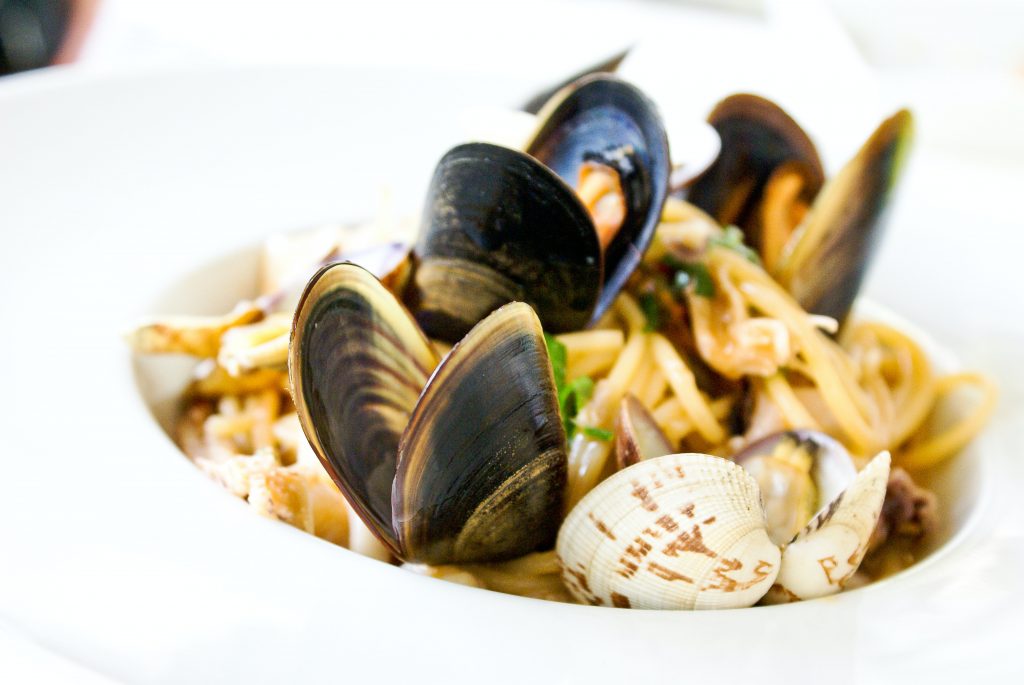Sustainable Seafood Buying Guide: Why Shellfish Are the Best

Shellfish like oysters, mussels, and clams are quickly turning into the rockstars of seafood sustainability, prized for being easy to farm and having a minimal ecological impact.
For people living in coastal communities, shellfish such as clams, mussels, scallops, and oysters are a common sight at the dinner table. While the average American has probably eaten shellfish at some point, they can be an overlooked part of our overall diet because of perception issues and lack of availability.
For example, bivalves like oysters and mussels have long had a reputation for looking unappetizing; they can be slimy, slippery, and difficult to prepare at home. However, research shows that they are probably the most sustainable food to eat and easily the most sustainable type of seafood.
In other words, now may finally be the time to champion shellfish.
Shellfish Explained
Shellfish is a broad term that encapsulates aquatic animals with shells or shell-like carapace. They fall under two main categories:
- Mollusks, which include bivalves such as oysters, scallops, clams, and mussels, and cephalopods like squid and octopus
- Crustaceans, such as crabs, shrimp, and lobster
Shellfish Are Nutritious

Generally speaking, shellfish are remarkably nutrient-dense and have a protein content higher than many types of meat and plant crops relative to their body weight. They’re also rich in specific nutrients and minerals, such as essential omega-3 fatty acids and iron, magnesium, and zinc.
For instance, here’s a closer look at the nutrient content of a 100-gram (3.5 ounces) serving of raw clams based on USDA data:
- Calories: 86
- Protein: 14.67
- Fat: 0.96
- Carbohydrates: 3.57 g
- Vitamin B1 (thiamine): 0.015 mg
- Vitamin B3 (niacin): 0.35 mg
- Vitamin B6: 0.01 mg
- Iron: 1.62 mg
- Magnesium: 19 mg
- Potassium: 46 mg
- Calcium: 39 mg
- Zinc: 0.51 mg
This nutrient density is why experts believe that bivalves may hold the key to solving the world’s many food issues.
Shellfish Have a Low Ecological Impact
Aside from being packed with a wide range of essential nutrients, cultivating shellfish also has massive benefits for the environment. As David Willer, a zoologist at the University of Cambridge, notes, “Bivalves have the remarkable potential to provide people with food that is not only environmentally sustainable but also nutrient-dense.”
In an article published in the journal Solutions, Jennifer Jacquet and her co-researchers argue that bivalves aren’t just the most ecologically sound animal species group; they’re also the best option for people that choose to eat animal products.
These claims come from the fact that oysters, clams, mussels, and scallops can be sustainably harvested from the wild and actively farmed offshore. Both processes also leave a fraction of the ecological footprint of traditional protein sources like beef, pork, and chicken. For context, beef produces up to 20 times more greenhouse gas emissions than mollusk harvesting and farming.
Bivalves also reduce concerns around sustainability and welfare in farms. For one, farm-raised shellfish have low-energy requirements as the water in pens does not require circulation. As filter feeders, these animals get their sustenance from the water itself, eliminating the cost and energy expenditure of sourcing and using animal feed.
Shellfish Harvesting and Cultivation Supports Marine Environments
Shellfish are not only a sustainable food source but their harvest and cultivation also supports balance in aquatic environments through the following:
- Sediment Quality – The act of harvesting shellfish from underwater surfaces loosens and disperses silt and sand, improving sediment quality. This process also allows oxygen to penetrate the seabed and bottom waters, helping aquatic plants and organisms grow.
Shellfish beds also help stabilize sediments, preventing shorelines from being eroded into the sea.
- Water Quality and Clarity – Shellfish also improve water quality by filtering seawater as part of their natural feeding behavior. As they feed on algae and food particles, adult oysters, for example, will filter as much as 50 gallons of water a day.
This filter-feeding process removes organic matter, bacteria, viruses, and excess particulates from the water column, dramatically improving water quality. This, in turn, encourages seagrasses and aquatic plants to thrive and generate more oxygen for marine animals.
- Algal Bloom Prevention – Shellfish can play a vital role in controlling algae blooms, like red tide, by absorbing nitrogen and algal particles before they reach dangerous levels. The caveat, however, is that shellfish can be toxic during algae blooms, hence the importance of keeping an eye on local fish and wildlife advisories.
- Marine Ecosystem Support – Shellfish beds support marine ecosystems by creating the conditions that allow other marine species, such as worms, crabs, and young fish, to feed and grow.
Shellfish are the Future of Aquaculture
Amid growing awareness about the importance of sustainable food sources, bivalves and other types of shellfish are shaping up to be the most promising in terms of environmental impact. Whether farmed or wild-caught, shellfish have the lowest ecological footprint.
From a consumer perspective, bivalves and other types of shellfish are also delicious, offering a mildly sweet and briny flavor. They are a flexible food ingredient that can be prepared in any number of ways and go well with soups, rice, and pasta.
For more buying guides and insights on seafood sustainability, be sure to follow the PanaPesca blog. You can also explore our shop and get free shipping on all orders over $150.

